September 1959 Popular Electronics
 Table of Contents Table of Contents
Wax nostalgic about and learn from the history of early electronics. See articles
from
Popular Electronics,
published October 1954 - April 1985. All copyrights are hereby acknowledged.
|
When color televisions hit
the stores in 1954, most households could not afford one. For that matter, most
households could not afford a black and white TV, either. By 1959 when this article
appeared in Popular Electronics magazine, TV in general was still a novelty to most people.
It is amusing to read about how much more lifelike everything would appear when
broadcast in "living color." Well, duh. It's as if it never occurred to anyone that
the images previously did not contain color like the real world did.
I was born in 1958, and remember that my family's was last of all the households
I knew of to own a color television set. We never even had a console floor model,
just small tabletop pieces of junk. It was a big deal the day I, at about age 16,
bought and installed a remote rotor for the rooftop antenna so we could receive
more than three stations. There was no cable TV service in our neighborhood (not
that we could have afforded it). I recall being amazed the first time I watched
The Flintstones in color and discovered that Dino the dinosaur was purple
and that Wilma had red hair! Who'd have known? It wasn't until after I went into
the USAF in 1978 that my parents ever owned a TV as large as 21" (not having to
feed and clothe me probably helped). Today, Melanie and I own just a single TV set,
and it is a Sharp 26" LCD. Most Welfare recipients relegate their taxpayer-purchased
TVs that small to the kitchen or bathroom.
Special Report on Color TV Today
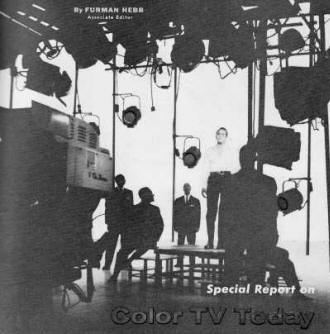 by Furman Hebb by Furman Hebb
All photographs courtesy of National Broadcasting Company
What's the truth about color TV? Is it everything it's claimed to be? Here are
the facts.
In 1954, when color television first became a commercial reality, the experts
all foresaw a rosy future for it. John. Q. Public was supposed to march right down
to his local appliance store and lay his money on the line for one of the new multi-hued
models.
But this John Q. Public did not do, and five years and 130 million dollars later
(RCA's estimated investment), what has been color TV's lot? Judged by any business
man's standards, it has gone over a like a lead balloon. Out of a total of 45 million
TV sets now in use, less than 500,000, or only about 1%, are color sets.
Ask the man on the street what he thinks of color TV, and chances are he hasn't
even seen it yet. If he has seen it, he will probably say: (1) the quality is poor,
(2) it's too expensive, (3) it's too difficult to tune, (4) there aren't enough
color programs, and (5) color sets break down too often.
Musical and variety shows are naturals for color TV. The Dinah Shore show is
particularly "colorgenic." Perry Como and Steve Allen are also color favorites.
Note the color background possibilities.
Facts About Color TV. Despite the fact that RCA has spent millions of dollars
advertising and promoting color TV, the foregoing impressions are strongly implanted
in the minds of a great many people. The awful pity of the situation is that, for
the most part, these impressions do not reflect the true facts.
After having surveyed a number of color TV set owners and service technicians
all over the country, and after having lived with a color set for a period of four
months, the writer has come to the following conclusions: (1) the visual quality
of color TV usually varies from good to very good and is often truly superb, (2)
the sets are not difficult to tune, (3) there is still not a wide choice of programs,
but color programing appears to be getting stronger with each new season, (4) the
service problem is not significantly more important than it is with a black-and-white
set (excluding one major consideration which we'll get to later), and (5) as far
as price is concerned, although color sets are undeniably expensive, the results
of our survey of color set owners indicate that the great majority feel they have
received full value from their sets.
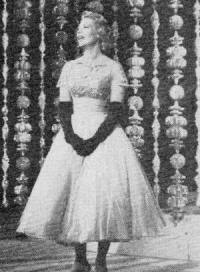
Musical and variety shows are naturals for color TV. The Dinah
Shore show is particularly "colorgenic." Perry Como and Steve Allen are also color
favorites. Note the color background possibilities.

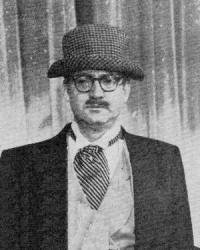
Special outstanding programs have been presented in color. The award-winning
"An Evening with Fred Astaire" was one. Others included the Old Vic presentation
of "Hamlet," and "The Green Pastures."
Color Set Owners
To find out exactly what people who own color sets think of color TV, a number
of owners were surveyed by mail. These people hailed from such diverse areas as:
Lansing, Mich.; Elizabeth, N. J.; York, Pa.; Whittier, Calif.; Fishkill, N. Y.;
Portsmouth, Ohio; Chicago; and Milwaukee.
Typical replies to the question, "What is your overall impression of color TV?"
were: "Beautiful," "Great," "Magnificent," "Exciting," and so on.
"Just one good color program a week offsets any additional cost of a color TV
set," one enthusiastic fan wrote. "Color TV is far more natural than color movies."
Another commented, "After two years with a color TV set, we cannot contemplate
any other means of home TV entertainment. We seldom miss a color program. Only rarely
do we go to movies because color TV is so satisfying."
The clincher was added by another fan. "We even enjoy commercials in color."
Almost unanimously, the owners reported that their sets have been easy to operate
and have performed reliably. None had encountered problems in getting his set serviced.
Most have found occasional adjustments of the controls necessary, but none considered
these adjustments difficult to make.
When asked how well their color sets received black-and-white programs, the set
owners generally agreed that a monochrome image is less sharp on a color set than
on an ordinary set. In addition, most color set owners reported a slight color tint
(usually a light bluish-green) on black-and-white programs. However, few people
objected to either the "soft" monochrome image or the color tint on the screen.
In general, the color set owners felt that black-and-white reception on their color
sets was as good as on their monochrome sets.
Although antenna requirements are more demanding for color than black-and-white
reception, the great majority of the color owners surveyed use their old antennas
with their color sets. Some, indeed, located near TV transmitters, report that they
use only an indoor "rabbit ears" antenna.
The concluding question on the questionnaire was, "Do you think the enjoyment
made possible by your color TV set has been worth the money you paid for it?" To
this most important question, the answer was a unanimous "Yes."
Service Technicians
In order to get opinions on color TV from the technical point of view,
it was decided to quiz the men who service color sets. The service technicians surveyed
were scattered from St. Louis to Sacramento, Chicago to Fort Worth, and from New
Orleans to Garfield Heights, Ohio. They have been handling color TV set repairs
for an average period of four years, and each turns out about 57 color repairs a
month. They indicated that, although in their experience color sets require slightly
more repair than black-and-white models, breakdowns of color sets are usually caused,
not by defects in the color circuitry, but by failures which are common to both
color and black-and-white sets - such as loss of sound, no vertical deflection,
power supply failure, etc.
Sports will receive color coverage this fall. NBC will telecast the World Series,
11 major football games, (including four "bowl" games) and the Davis Cup tennis
matches. Color gives sporting events a feeling of depth and realism.
It was generally agreed that it is slightly more difficult to a repair a color
set than a black-and-white set. The average repair cost reflected this; whereas
the average re-pair bill for a black-and-white set was reported to be about $25.00,
the average color set repair amounted to about $30.00.
Of the technicians surveyed, half already own color sets and the remaining half
indicated that they plan to buy color sets. In general, they feel that color TV
is "very good" and they would be very optimistic about its future if the number
of color shows were to increase.
Tough Row to Hoe
Any discussion of color TV should point out that two closely linked corporations,
RCA and its affiliate NBC, in truth, are color TV. These two colossi of the electronics
world together have produced well over 90% of all the color programs transmitted
and over 90% of the sets to receive them on. With very little support from the rest
of the industry, they have taken on the task of selling color TV to the American
public. At this time, with over 130 million dollars sunk into poly-chrome TV, it
is most unlikely that they will slacken their efforts.
But RCA and NBC, in their efforts to popularize color TV, are confronted by a
double-headed monster: price and programing. If these two problems could be solved,
there is no doubt that color TV would fulfill every optimistic speculation of five
years ago.
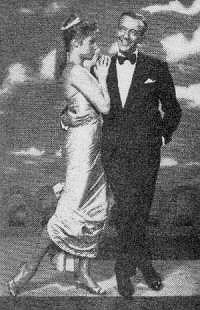
Special outstanding programs have been presented in color. The
award-winning "An Evening with Fred Astaire" was one.
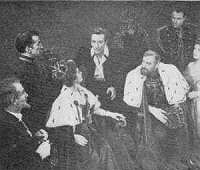
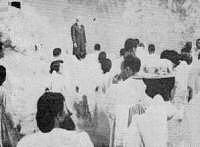
Others included the Old Vie presentation of "Hamlet," and
"The Green Pastures."
Obviously if there were a wider choice of color programs, a person would have
a much greater incentive to buy a color set than he has presently. However, color
programing will never be what it can be until more color sets are in use. NBC's
biggest competitors, ABC and CBS, have made it quite clear that they will start
doing a bang-up color programing job only when "the people want it" - meaning, of
course, when enough people have color sets to make it economically attractive to
sell color shows to sponsors. In the meantime, NBC has to keep color programing
going practically single-handedly; ABC hasn't done anything in color and CBS makes
only a token contribution to color programing.
Panel shows are probably the most fruitless subject for color TV. When the typical
viewer sees "the Price Is Right" or "Haggis Baggis," in color, he may well say,
"So it's in color - so what?"
Looking at things from a TV set manufacturer's viewpoint, you can't' really blame
him for being hesitant about going into the business of turning out high-priced
color sets at a time when many people would refuse to buy them because of the lack
of more color programing. Consequently, with both the networks and the TV manufacturers
waiting for the others to make the first move, color TV is caught in the middle
of a game of "let's-wait-and-see." The question is: Which will come first, the chicken
(in the form of lower priced color sets) or the egg (more and better color programs)?
Quality of Color
As far as the visual quality of the finished product is concerned, as indicated
earlier, it is variable - but rarely less than acceptable. Good color TV is a color
experience as exciting and beautiful as any you'll ever run across - and this includes
the results of any printing process and the highest quality color film.
If you have seen color TV in a store or in a bar and haven't been impressed,
there can be two explanations: first, the set might not have been properly adjusted,
and secondly, the level of illumination in the room may have been too high. In order
for color TV to look its best, it must be shown in a considerably darker room than
is suitable for black-and-white TV. If the room lighting is too bright, the picture
will look weak and washed out: if the color control is turned up excessively in
an attempt to give the picture more pep; it is almost impossible to achieve the
correct color balance. Live shows which originate under studio conditions generally
provide the best color quality. The "Dinah Shore Chevy Show" comes live from California
and is undoubtedly the top color show on the air. On the other hand, the "Steve
Allen Show," which is also live, is less consistent in its color quality. This just
proves it's not only the process, but the man behind the process, that counts. Dinah
apparently has better technicians.
Filmed color, if expertly done, is almost as good as live color. "Northwest Passage,"
a filmed adventure series, generally has very good color, especially in the outdoor
sequences.
To date, color-taped shows have been less satisfactory than either of the other
two methods, with the color frequently appearing unsaturated and weak. Perhaps as
the recorders and the tape are improved, color video tape will rival the other two
processes. This would be very important economically, since color tape is about
15% cheaper than color film.
Truly poor color quality is almost always caused in the studio rather than in
the receiver. Getting the light evenly distributed over the stage is a very ticklish
problem. Occasionally a performer who is off-center falls into an area of illumination
which is either "hot" or "cold." When this happens, his face may go out of color
balance and turn either greenish or bluish-red. In severe cases, the unlucky actor
may look as if he came from another planet. Improper color balance can be corrected
in the studio, and distortions of this type will probably disappear as technicians
become more skilled and as the equipment is made more self-correcting.
Depth and Realism

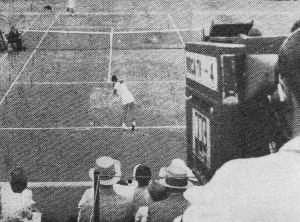
Sports will receive color coverage this fall. NBC will telecast
the World Series, 11 major football games (including four "bowl" games) and the
Davis Cup tennis matches.

Color gives sporting events a feeling of depth and realism.
The most frequent words you'll find applied to color TV in the advertisements
are "depth" and "realism." Now these don't mean much when you read them. They're
just words. But the truth of the matter is that color does bring a genuine feeling
of depth to the TV screen. When objects and people appear in their natural colors,
you seem to see them inside the picture tube, rather than on the screen of the tube.
It's not a true "3-D" effect, of course, but sometimes it comes remarkably close.
This feeling of depth accounts for part of the "realism" of color TV. But the
different colors themselves add interest and realism. In color TV, as in painting,
it is possible for the most banal subject to become a visually interesting experience
by virtue of its color values alone. No matter what the subject matter, if color
is handled skillfully, it can be enormously exciting.
The Sets Themselves
The first color sets had 15" screens, four controls for color alone, and were
priced at a cozy $1000. In addition, the four controls worked together something
like a combination lock. Each had to be set in just the right position before a
good color picture could be received.
Color sets today have 21" screens, use only two extra "color" controls, and are
priced as low as $495.00. This isn't exactly cheap, of course, but from time to
time special offers bring the price down more.
From the user's point of view, the greatest improvement in today's color sets
over earlier models is the ease of tuning. There is no longer just one correct "combination."
If you misadjust one control, it is usually possible to compensate with either the
other color control or the fine' tuning, or by a slight reorientation of the antenna
(if it's handy).
The two color controls are: (1) COLOR, which acts as a volume control, adjusting
the intensity of the color, and (2) TINT, which varies the color balance. After
the set is adjusted for normal black-and-white reception, when a color program comes
on all you do is set the COLOR control for the minimum amount of color required
to saturate the screen satisfactorily and then adjust the TINT, or color balance
control, for natural flesh tones. If this is done, all colors will automatically
come in with the correct balance.
The Servicing Problem
When the first color sets came on the market, the price for an RCA one-year service
contract was $149.50. Today, the price has come down to $69.50. Included in the
$69.50 is installation and one year's service, with all parts being factory-guaranteed
for the first year. However, since the parts guarantee expires after the first year,
the price of a service contract jumps up in following years.
For these succeeding years, RCA offers two types of service contracts: a complete-coverage
plan for $119.50 per year; or a "Preferred Rate" plan for $79.50 a year. The latter
contract covers all parts and "limited" service - meaning that a flat fee of $5.95
is charged for each service call after the first one.
Now, do you really need a service contract? It boils down to how much of a gambler
you are. Look at it this way: since a color set has more tubes than a comparable
black-and-white set, it's common sense to expect more breakdowns from a color set.
For some reason, though, the incidence of color set repair has not been nearly as
high as some people expected.
Anyway, let's assume you'll have just a little more trouble with a color set
than black-and-white set. Let's say, for example, that instead of calling a service
man three times every two years, you call him twice a year. If the average cost
of a color set repair were $30.00, you would pay only $60.00 a year as opposed to
either $119.50 or $85.45 ($79.50 plus one free call and one $5.95 call) in service
contracts.
If a color set didn't have a hidden "joker," it would seem to be a pretty safe
risk to go without a service contract. But there's one little item in a color set
that isn't found in a black-and-white set-the color picture tube. If your color
picture tube burns out, you will suffer the ultimate disaster. You can figure on
paying about $150.00 for color picture tube replacement plus service.
So, when you buy a service contract, to a great extent you are paying insurance
on the picture tube. While there has been no unusual amount of difficulty with color
picture tubes (replacements are currently running in about the same ratio as black-and-white
picture tubes), you can see why it takes quite a gambler to operate a color set
without a service contract.
Future of Color TV

Panel shows are probably the most fruitless subject for color
TV.

When the typcal viewer sees "the Price Is Right" or "Haggis Baggis,"
in color, he may well say, "So it's in color-so what?"
There are sever indications that color TV may really get going either this year
or next year. First of all, NBC has announced a very attractive schedule for the
fall which outlines 250 hours of color programing, 30% more than was presented during
the same period last year. The NBC line-up will include all the NBC color regulars
such as Dinah Shore, Perry Como, Steve Allen, etc., and will feature numerous color
"specials" - musicals, plays, educational programs, comedy and sports. Included
in the sports coverage will be the World Series and 11 major football games. Accompanying
this truly excellent color schedule will quite likely be a full-scale advertising
campaign for color
Also, news that the Admiral Corporation is plunging into the production of a
complete line of color sets points to a new confidence in the future of color TV.
Admiral envisages a mass market opening up in 1961.
As mentioned earlier, the two things holding up color TV are price and, programming.
With NBC's increase of "color programing this fall, at least part of the problem
is being solved. It is doubtful, however, that any tremendous breakthrough will
come until the price of the sets comes down. When color sets are priced within $100
of comparable black-and-white models, then color TV will come into its own. Until
that time it seems probable that it will make steady but unspectacular progress.
Color TV and You
Now for the $64 question - or more exactly, the $495 question: Should you buy
color TV now?
Very frankly, it all depends on how much money you have. If you can afford a
boat, or an extra car, or an automatic dishwasher, then the enjoyment you will get
from a color TV set should be well worth what you pay for it. And even if you can't
really "afford" a set, it might still be worth $495 to you.
One word of warning, though, if you get a color set, don't tell your friends
- unless you're prepared to spend your evenings demonstrating it. And don't forget
to order the beer and pretzels!
Color and Monochrome (B&W) Television
Articles
Posted November 2, 2021
(updated from original post on 4/5/2012)
|





















